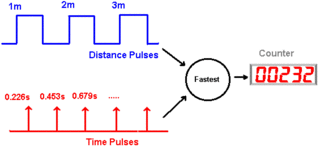Taking your pulse in the City
Apparently, you are charged for time or distance and not both at the same time (check link for details). So what is the incentive of the taxi driver under this scheme? Well common sense says the taxi driver wants to drive as far as possible in as short a time as possible, hence recording tons of meter clicks. However, it also allows for compensation during a traffic jam (or any speed less than about 16 km/h), which may alleviate sidewalk driving and the such.
So what would happen if you raised the fee of the time rate or lowered that of the distance rate? Well, driving slowly would be less costly, so you may not get to your destination as fast, but perhaps you'd get there in one piece.
Question: Can anyone find accident statistics on Taxis relative to other types of Drivers?

No comments:
Post a Comment